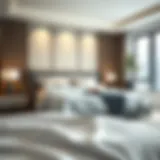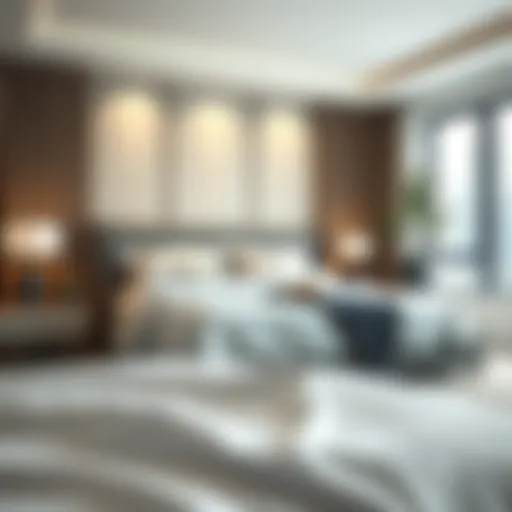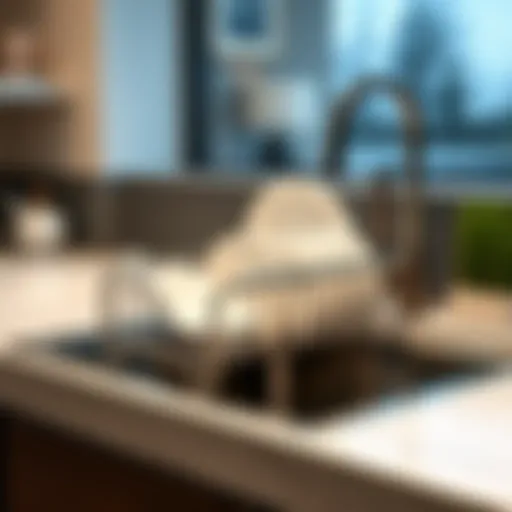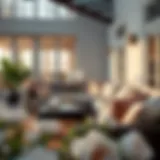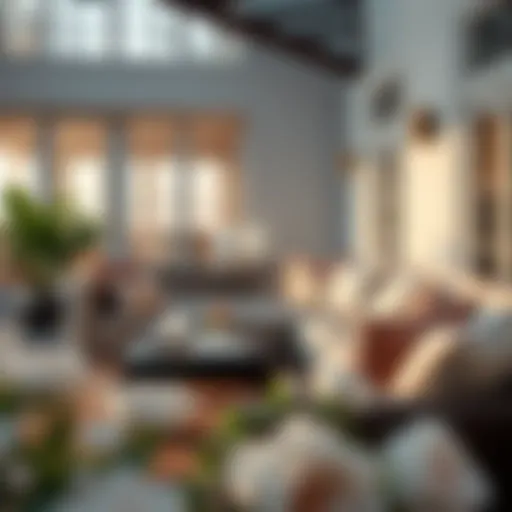Stylish Small End Tables with Storage for Modern Homes
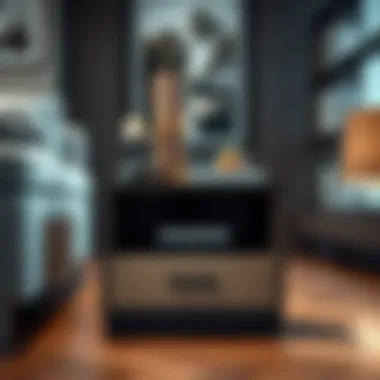
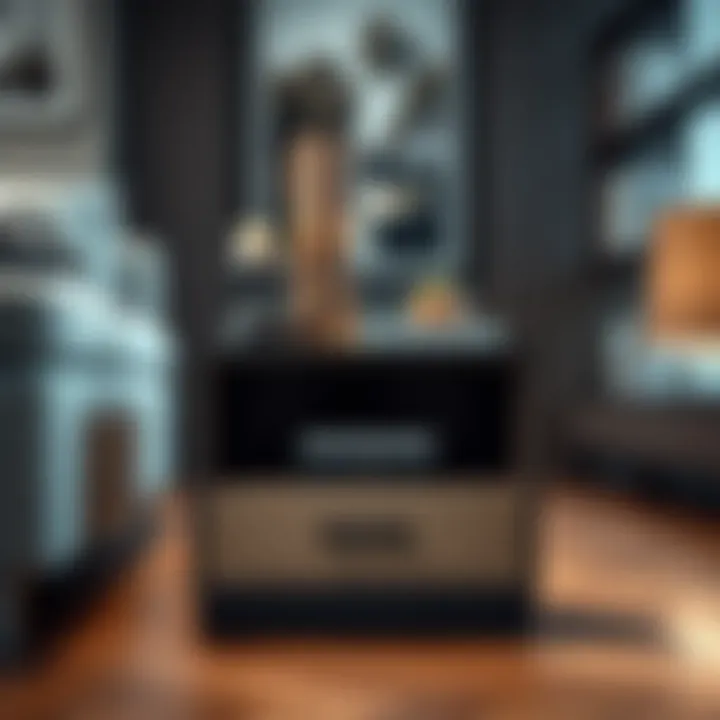
Intro
Small end tables with storage are more than just functional pieces of furniture. They occupy a unique space in home decor; not only do they serve as convenient surfaces for lamps, drinks, or books, but they also offer hidden compartments for stowing away items that you want to keep nearby yet out of sight. The rising popularity of these multi-purpose tables reflects a broader shift in modern design where both style and utility take precedence. Whether in a cozy apartment or a sprawling house, these versatile helpers can elevate your living space while making it as practical as a Swiss Army knife.
Furniture Styles and Trends
When it comes to choosing the right small end table with storage, understanding current furniture styles and design trends can significantly influence your decision. Homeowners today prioritize not just aesthetic appeal but also how well a piece meshes with their overall decor theme.
Modern vs. Traditional: Understanding the Aesthetics
Modern designs lean heavily on minimalism and clean lines, often favoring materials like metal and glass. In contrast, traditional designs showcase ornate details and rich woods, catering to a more classic taste. Here’s a closer look at each:
- Modern End Tables: Typically designed with sleek finishes and functional features, they often incorporate storage solutions such as drawers or shelves hidden creatively. A simple cube design may contain slide-out drawers that aren’t visible unless opened, giving a flush look to any room.
- Traditional End Tables: Crafted from sturdy wood with intricate carvings, antique finishes often draw in people who appreciate history. Many boast spacious storage compartments, like cabinets styled to resemble vintage furniture, thus enhancing both practicality and elegance.
Deciding between modern and traditional ultimately comes down to what resonates with your personal style and existing decor. Don’t be afraid to mix elements from both categories for an eclectic look that reflects your own taste.
Color and Material Trends: What's In and What's Out
Color schemes play a vital role in the overall design sensibility of your space. Currently, soft earth tones and muted pastels dominate home decor palettes, promoting a sense of calm and warmth. On the other hand, materials like reclaimed wood or matte metals are gaining ground. They not only look good but are also environmentally conscious choices, which resonate with the growing trend of sustainable living.
"Furniture should make a statement, but it should also make a home functional. That’s where end tables with storage come in."
Furniture Care and Maintenance
Investing in a small end table doesn't merely involve a purchase; it comes with the responsibility of upkeep. Proper care can ensure your furniture ages gracefully and lasts for years.
Tips for Prolonging the Life of Your Furniture
- Regular Cleaning: Dust regularly with a soft cloth to prevent buildup. For wood, consider using a natural wood cleaner to maintain its shine.
- Avoid Direct Sunlight: Keep your tables away from direct sunlight to prevent fading and warping in wooden pieces.
- Use Coasters: If drinks are often placed on the surface, coasters will protect the top from rings and stains.
These simple practices can go a long way in preserving the beauty and function of your end table.
DIY Repair Hacks for Common Furniture Issues
Even the most well-loved furniture can develop wear and tear over time. Here are some quick DIY fixes:
- Scratches on Wood: A walnut can work wonders. Simply rub the meat of the nut over the scratch, and the natural oils will help blend it.
- Loose Joints: If an end table begins to wobble, consider applying wood glue to any loose joints for a secure hold.
Knowing how to handle minor issues can save stress and money.
Finding the right small end table with storage for your space doesn’t need to be daunting. With the insights provided here, you can make an informed decision that complements your home while adding functionality. This guide aims to equip homeowners, designers, and DIY enthusiasts with the knowledge needed to navigate the intricate landscape of furniture selection and maintenance.
Foreword to Small End Tables with Storage
In today’s living spaces, every square inch counts. Small end tables that offer storage are not just pieces of furniture; they serve a huge purpose. They blend utility with style, providing space for essentials while enhancing the decor. With the ongoing trend of downsizing and urban living, understanding these small wonders becomes vital for homeowners and designers alike.
Defining the Concept
At their core, small end tables with storage are multifunctional items that combine a traditional side table's purpose with added compartments. Think of them as the Swiss Army knife of furniture – compact, yet full of possibilities. They typically feature drawers, shelves, or even hidden nooks that help keep clutter at bay. For example, consider a cozy reading nook where a small table next to the armchair can store magazines, remotes, or even coasters. The practicality of these tables makes them a favored choice in many homes.
Importance in Modern Home Design
Modern design often emphasizes minimalism and functionality. Small end tables with storage cater to this philosophy beautifully. These tables maximize the use of space without sacrificing aesthetic appeal. By choosing wisely, one can find a piece that complements the overall design while providing necessary storage.
Consider this: A well-placed end table can become the focal point of a room, especially if it matches or contrasts with existing decor in a thoughtful way. In a fast-paced world where organization and simplicity are paramount, these tables transform from mere functional items to essential components of modern living.
"In a world of clutter, small end tables with storage serve as havens for both style and organization.”
Homeowners and designers looking to enhance their spaces should take note of the versatility these tables provide. Whether it's in a small apartment or a spacious house, they fit seamlessly into various environments. Their design has become increasingly sophisticated, allowing users not just to manage space but also to express personal style. Thus, small end tables with storage have earned their place in contemporary design discussions, making them worthy of further exploration.
Functionality and Practicality
When it comes to small end tables with storage, the essence lies in how well they serve a dual role: creating a style focal point in your living space while offering much-needed utility. In an age where living spaces are often tight, the importance of functionality cannot be overstated. These tables help address storage challenges without compromising on aesthetics. They streamline clutter, create convenience, and, more importantly, ensure areas do not feel cramped or chaotic.
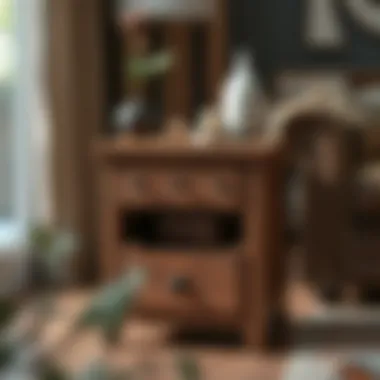
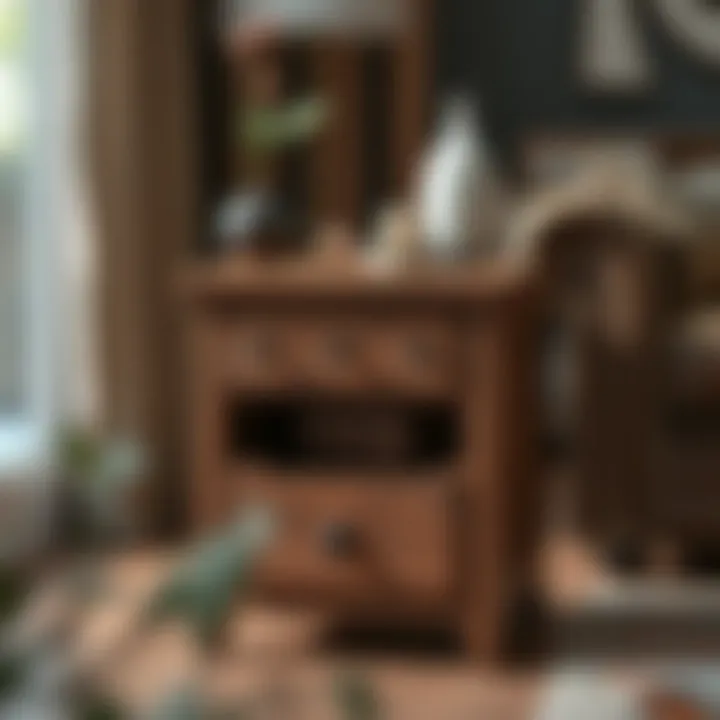
Optimizing Space in Smaller Areas
In smaller homes or apartments, every square inch counts. Small end tables with robust storage solutions can transform a compact area into a more functional space. These tables can tuck neatly beside a sofa or chair, yet they harbor significant hidden storage. By often combining style and utility, they present a way to maximize horizontal space without overwhelming a room.
Consider a living area where space is at a premium. With the right end table, you can store items like magazines, remote controls, or even throw blankets without cluttering the surface. This clever optimization creates an airy feel, making the area look more spacious despite limited square footage.
"A small end table doesn’t just serve as a surface—it conceals, organizes, and transforms a cramped corner into a cozy nook."
Storage Solutions to Consider
Drawers
Drawers are a quintessential aspect of small end tables. They offer a discreet way to stash away items while Keeping everything handy. The ability to simply open a drawer and tuck away personal belongings makes them a popular choice. One particularly appealing feature of drawers is their customization; they are available in various sizes and designs that suit distinct aesthetics. Furthermore, having a drawer can significantly reduce the visible clutter on the tabletop. The main advantage here is the accessibility they provide—grab what you need with a simple pull.
However, the downside is that drawers can sometimes be cumbersome. They require enough clearance to open fully, and if packed too tight, they may become a little tricky to navigate.
Shelves
Shelves add another layer of versatility to small end tables. They not only act as storage spaces but also double as display areas for decorative pieces. This means a table with a shelf can showcase books, plants, or other items while still providing storage at the same time.
The key characteristic of shelves is their visibility, which can be a pro and con. On one hand, you can keep your treasures on display; on the other, this could lead to the accumulation of dust or disorganization if not managed carefully. Solid designs help make these shelves a solid choice in terms of both style and function. With varying heights and depths available, they can fit diverse designs and purposes.
Hollow Spaces
Hollow spaces in an end table's structure often provide surprising storage options. These voids can house anything from magazines to pet toys, depending on their size and shape.
The standout feature of hollow spaces is that they maintain an open look while still offering underground storage. They can empower homeowners to be creative—using baskets or lovely boxes that fit perfectly into the hollows can instantly enhance their practicality and aesthetic appeal. However, it’s crucial to note that managing these spaces requires an eye for detail. Without thoughtful organization, these areas can become catch-alls, detracting from the pristine look of your room.
Design Styles of Small End Tables
When it comes to small end tables with storage, design styles play a pivotal role in how these pieces harmonize with the overall decor of a space. The right style not only enhances the aesthetic value but also complements functionality. With varying trends and tastes, it’s essential for homeowners, designers, and enthusiasts to consider how each design style can serve their needs while aligning with personal preferences. The importance of choosing the right design cannot be understated, as it impacts both functionality and visual appeal in a home.
Traditional Approaches
Traditional end tables often embody craftsmanship that reflects historical styles and cultural elements. These tables typically showcase rich woods like mahogany or cherry, ornate carvings, and decorative hardware. What stands out is the focus on permanence and timelessness. These design choices exhibit a certain dignity—a characteristic often appreciated in classic decor.
The beauty of a traditional small end table lies in its ability to effortlessly blend into formal and informal settings alike. Think of a cozy reading nook where a classic end table adds not just functionality, but also a heritage vibe. When selecting a traditional table, consider its integration with vintage decor or even juxtaposed against modern furnishings for an unexpected twist.
Contemporary Designs
Contemporary styles are a reflection of the ever-evolving aesthetic landscape. These designs favor clean lines, innovative shapes, and an emphasis on functionality. Often crafted from materials such as light-colored woods, metals, or even acrylic, contemporary end tables tend to possess a lightweight look. This modernity invites a fresh approach to both form and function.
An advantage of opting for contemporary designs is their versatility.
- They effortlessly adapt to various settings, from minimalist spaces to eclectic arrangements.
- Their streamlined profiles can make small areas feel more spacious while ensuring that storage solutions do not compromise the decor.
Adding a contemporary end table can encourage a more dynamic design narrative, bridging the gap between diverse styles in your home.
Industrial Trends
Industrial style brings an edgy, raw character into play. With a preference for utilitarian design, these end tables often flaunt combinations of wood and metal, adopting a more rugged aesthetic. Features may include distressed finishes, exposed hardware, and a no-frills approach to craftsmanship. This style is particularly popular among urban dwellers who appreciate a more laid-back, casual feel.
One key element of industrial end tables is their emphasis on functionality over formality. They can easily fit within loft-style apartments or as a contrast against softer furnishings in a suburban living room. The rugged charm combined with practical storage options taps into the nostalgia for factories and warehouses, making them much loved among those who embrace a modern rustic environment.
Minimalistic Aesthetics
A minimalist approach to end tables focuses on simplicity and essentialism, shedding any unnecessary clutter. The aim here is to capture beauty through less-is-more philosophy, often featuring muted colors and smooth surfaces. Materials used can range from plain wood to sleek metal finishes, but with an emphasis on functionality and organization.
- Benefit of Minimalism: This design choice helps create a serene environment in often chaotic spaces.
- Consider how a sleek, uncluttered end table can bring balance to a room filled with vibrant decor or how it serves as a focal point that does not overwhelm the visual landscape.
Choosing a minimalistic end table can be particularly useful for smaller living spaces where every inch counts. It allows you to maximize utility while invoking a sense of calm.
"In the world of design, even the smallest pieces can impart significant impact—especially if they capture the essence of style tailored to the space they inhabit."
In summary, the various design styles of small end tables each bring their own unique flair to home decor. From the classic beauty of traditional styles to the sleek simplicity of minimalism, each offers distinct features that cater to different tastes and functional requirements. Homeowners and designers should carefully assess how these styles align with their vision to create harmonious living spaces.
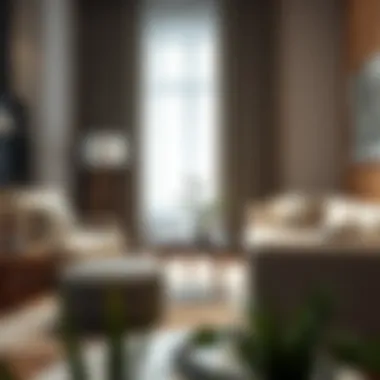
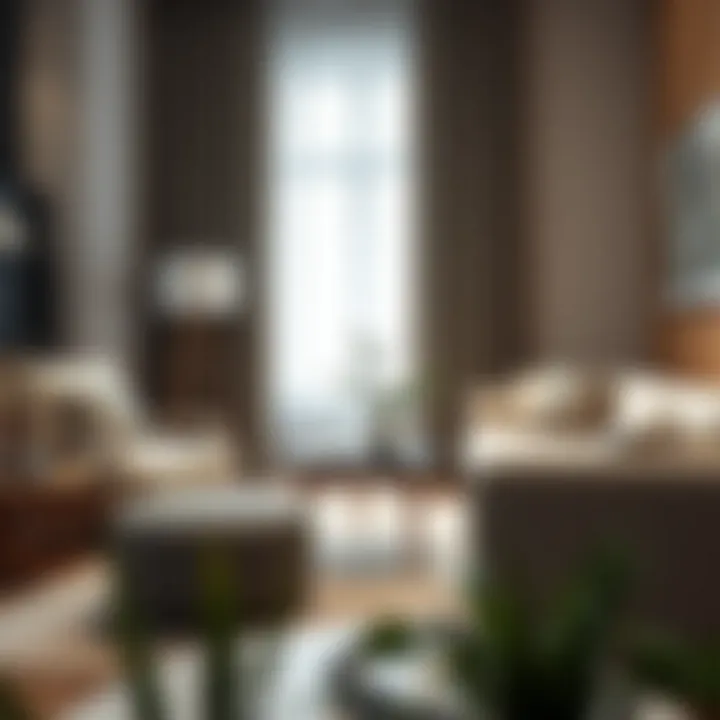
Material Choices for End Tables
Selecting the right materials for small end tables is crucial in determining their durability, aesthetics, and overall function. Materials not only contribute to the structural integrity of these tables but also impact how they interact with your home’s decor. The options available can cater to various preferences—whether you lean towards traditional styles or modern chic designs. Having storage capabilities adds another layer of consideration, as some materials lend themselves better to functional designs. Let’s dig deeper into the specific materials often used in building these versatile pieces.
Wooden Structures
Wood has long been a favored material for furniture due to its warmth and timeless quality. It's important to note that wooden structures can be further categorized into two main types: solid wood and engineered wood.
Solid Wood
Solid wood is the crème de la crème when it comes to furniture. This type of wood is derived from a single piece of timber, making it exceptionally sturdy and long-lasting. One of its key characteristics is its ability to develop a rich patina over time—something that can elevate the look of small end tables.
- Benefits: The use of solid wood not only guarantees durability but also offers a unique grain pattern, which makes each piece one-of-a-kind.
- Downside: It can be pricier than other options, and depending on the finish, it may require more maintenance to protect against scratches and stains.
The longevity of solid wood makes it a viable investment for homeowners looking for quality that stands the test of time.
Engineered Wood
Conversely, engineered wood—often made from products like MDF (medium-density fiberboard) or particleboard—is another popular choice for end tables. Its construction involves bonding together wood fibers, which creates a stable and consistent surface.
- Benefits: Engineered wood is typically more affordable and can come with a variety of finishes that mimic the appearance of solid wood without the associated costs. This makes it an attractive option for people wanting stylish furniture on a budget.
- Downside: Though it is durable, engineered wood might not withstand extreme weight or damage as well as solid wood. It's also not as easily refinished, making it less adaptable in the long run.
Metal Frameworks
Metal frameworks offer a striking contrast to wooden surfaces and can introduce an industrial edge to small end tables. Often made from materials like stainless steel or wrought iron, these tables provide strength and a sleek aesthetic.
- Benefits: Metal is resistant to water and pests, making it ideal for a variety of settings, especially in homes with fluctuating climates.
- Downside: While durable, metal can be prone to scratches and dents, which may affect its appearance over time.
Glass Top Finishes
Glass top finishes add an air of elegance to small end tables. They can be paired with any base material—wood, metal, or even acrylic—enriching their design potential.
- Benefits: Glass surfaces are easy to clean and reflect light, creating a sense of openness in a room, particularly useful in smaller spaces.
- Downside: However, they can be prone to fingerprints and are often less forgiving when it comes to impacts.
Alternative Eco-friendly Materials
In today's climate of sustainability, alternative eco-friendly materials are becoming increasingly popular for end tables. Options like bamboo, reclaimed wood, or recycled materials are not only stylish but also demonstrate a commitment to environmental responsibility.
- Benefits: These materials can often be more sustainable than traditional sources, appealing to eco-conscious consumers. They also add a unique character to furniture due to the variety in textures and finishes.
- Downside: One trade-off might be durability, as some eco-friendly options may not stand up as well to wear and tear as solid wood or metal structures.
By carefully considering the different material choices available, homeowners and designers can select the perfect end table that not only enhances their space but also meets their functional requirements.
Color and Finish Considerations
When it comes to small end tables with storage, the choice of color and finish is not just a matter of aesthetics; it plays a critical role in how these pieces fit into the broader context of home design. The color palette and finish you choose can influence the mood of a room, enhance the functional aspects of the table, and tie together existing decor elements. Understanding the implications of color and finish choices can elevate the way these often-overlooked pieces contribute to space.
Neutral Tones
Neutral tones offer a versatile foundation for small end tables. Colors like beige, gray, and white create an understated elegance that seamlessly blends into a variety of interior styles. These shades can make a room feel airy and spacious, an essential consideration especially in smaller living areas.
- Advantages of Neutral Tones:
- Flexibility: They allow for easy changes in decor without clashing with other elements.
- Timelessness: Neutral colors tend to withstand the test of time, making them a prudent choice for investment pieces.
- Highlighting Other Elements: They can bring attention to statement decor items, such as artwork or colorful cushions, rather than drawing focus themselves.
However, while neutral colors provide a backdrop, they shouldn't be mistaken for bland. The finish on these tones can elevate them significantly. A matte finish offers a subtle, modern touch, whereas a gloss finish can add a bit of shine, injecting a sense of contemporary style into a more traditional setting.
Bold Colors for Statement Pieces
On the other end of the spectrum, bold colors are for the audacious. A small end table in a vibrant hue, like cobalt blue or sunny yellow, can act as an eye-catching focal point in a room.
- Benefits of Bold Colors:
- Energy and Dynamism: They tend to bring a liveliness to the space and energetic vibes that neutral tones can't.
- Personal Expression: Incorporating bright colors allows homeowners to showcase their personality and unique taste in a way that's more striking than neutral palettes.
- Defining Zones: In open-plan living spaces, bold colored end tables can serve as visual anchors, helping to delineate different areas within a larger space without the need for walls.
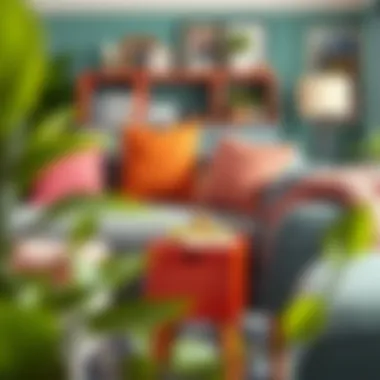
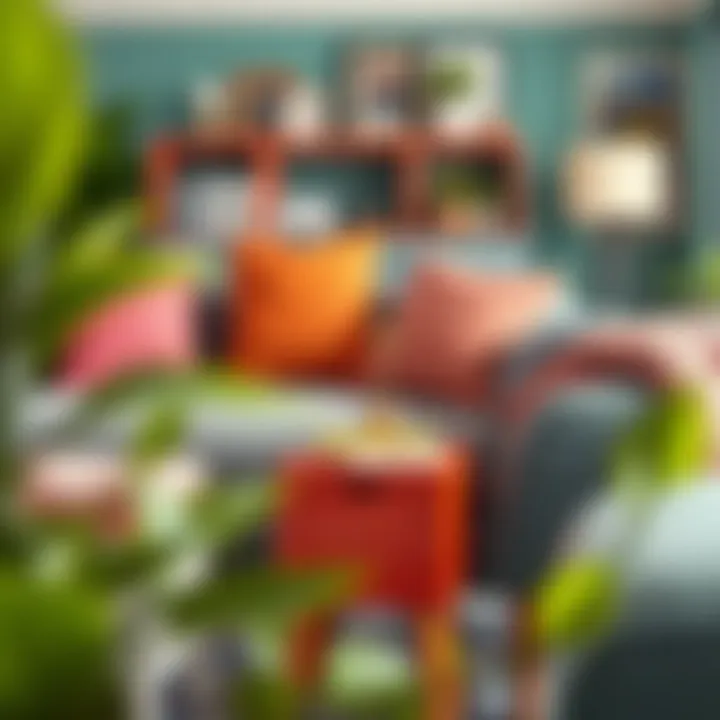
One might consider adding a bold colored end table to contrast with more subdued furnishings or artwork—it’s about balance. Remember too that the finish complements these colors. A matte finish can soften a vivid hue, while a glossy coat enhances it, adding depth and dimension.
"Color is the keyboard, the eyes are the harmony, and the soul is the piano with many strings." - Wassily Kandinsky
Ultimately, the right color and finish choice can elevate a small end table from mere utility to a chic design statement in the home.
Integrating End Tables into Living Spaces
When it comes to making a home feel cohesive, small end tables with storage play a pivotal role. These tables serve not only as functional pieces but also as decorative accents that can pull a room together. To understand their significance, one must consider how they integrate into various living spaces, providing both aesthetic charm and practical utility.
Positioning and Layout
The positioning of end tables is not merely about finding an empty spot; it's about maximizing function while enhancing the overall flow of the living area.
- Consider Sight Lines: When placing an end table next to a sofa or chair, ensure it does not obstruct views across the room. A table that is too tall or awkwardly positioned can disrupt the visual harmony.
- Accessibility Matters: It's wise to have these tables within arm's reach of seating. This encourages their use for holding drinks, books, or other items one might need while lounging.
- Balance the Space: Try to align end tables with similar heights to other furniture, like the armrests of sofas. This creates a sense of equilibrium within the room. An uneven setup can make a space feel cluttered or lacking in purpose.
Using these pointers, homeowners can craft a layout that isn’t just visually appealing but functional, allowing small end tables to serve their dual purpose effectively.
Complementing Existing Furniture
To complement existing furniture, small end tables with storage need to work in tandem with other pieces, making the overall decor not only cohesive but also tailored.
- Harmonize Styles: Choose end tables that reflect or subtly contrast the existing furniture styles. For instance, a rustic wooden end table can add warmth to contemporary furniture, creating a delightful mix.
- Color Coordination: It is useful to consider the color palette of the room. A neutral table can ground a room bursting with color, while a bold table can serve as a statement piece, drawing the eye effectively.
- Texture and Material Match: Matching or varying the textures across surfaces can enhance visual interest. For instance, pairing a sleek glass-top end table with a plush sofa can provide tactile balance.
By thoughtfully positioning these tables and selecting pieces that complement existing furniture, homeowners can create a living space that feels both functional and visually inviting.
Emerging Trends in End Table Designs
In recent years, the realm of home décor has witnessed a significant evolution, particularly regarding small end tables with storage. These pieces, once considered mere functional items, have transformed into essential components of modern interior design, offering both utility and style. The emphasis on emerging trends in end table designs reflects broader shifts in how we approach living spaces, espousing a blend of innovation, functionality, and sustainability.
As homeowners and designers seek to maximize spaces without compromising aesthetic appeal, understanding these trends becomes increasingly crucial.
Smart Furniture Innovations
The integration of technology into furniture design is hardly a new concept, but it has accelerated in recent years, especially with end tables. Smart furniture incorporates features such as wireless charging capabilities, Bluetooth speakers, and app-controlled lighting, bringing convenience to a new level. This innovation caters not only to the tech-savvy consumer but also to those looking to streamline their living environments.
For instance, imagine an end table equipped with a built-in coffee warmer or adjustable LED lights that can match your mood. Such innovations don’t just make life easier; they also enhance the overall aesthetic quality of living spaces, merging functionality with modern art. Still, when considering smart features, it’s essential to think about power sources and access to outlets. Poor planning can turn what should be a seamless experience into a hassle.
"Innovation isn’t about saying yes to everything. It’s about saying no to all but the most essential features." – Steve Jobs
Sustainability in Production
Sustainability is more than just a buzzword in today’s market; it’s a lifestyle choice that resonates deeply with a growing segment of consumers. As awareness of environmental issues rises, homeowners are increasingly prioritizing eco-friendly materials and manufacturing processes when selecting their end tables.
Many brands now offer pieces made from reclaimed wood, recycled metals, or sustainable bamboo, providing options that lessen the carbon footprint without sacrificing style.
Additionally, the production of these tables often emphasizes ethical labor practices, which appeals to a conscientious audience. When selecting an end table, buyers are now more conscious than ever of where their furniture comes from and how it’s made. They want assurance that their purchases are benefitting the planet and not harming it.
In essence, these emerging trends not only elevate the utility and beauty of end tables but also create a more mindful, modern approach to interior design. By keeping abreast of these developments, both designers and homeowners can make informed decisions that transform spaces while aligning with contemporary values.
Epilogue
In wrapping up our exploration of small end tables with storage, one can appreciate the unique blend of utility and aesthetics they present in both modern and traditional homes. These compact pieces of furniture are not just surfaces for your afternoon coffee or a cozy lamp; they are significant storage solutions that can help declutter your living area, especially in smaller spaces. With a myriad of designs, from minimalist to contemporary, end tables serve a dual purpose, enhancing the décor while providing practical storage options.
"Small spaces can pack a punch with the right furniture choices."
Summarizing Key Insights
When considering small end tables equipped with storage, several key points have emerged from this discussion:
- Versatility in Design: These tables are available in various styles and materials, allowing you to choose ones that suit your personal taste and existing decor. From wooden to metal frameworks, the choices are extensive enough to cater to anyone seeking sophistication or rustic charm.
- Enhanced Functionality: Beyond serving as a simple table, they offer solutions to everyday storage problems through compartments, drawers, and shelves. This functionality is vital, especially in apartments or less spacious homes where every square foot counts.
- Integration into Living Spaces: Proper positioning and the ability to complement existing furniture enhance the utility of these tables, allowing them to fit seamlessly into the living environment while adding character.
Understanding the blend of functionality, aesthetics, and practical use, homeowners can make more informed decisions regarding their furniture selections, ultimately fostering a more organized and stylish living space.
Future Outlook for Furniture Choices
As trends in home decor evolve, small end tables with storage are likely to keep pace with changing consumer needs.
- Smart Innovations: Technological integrations, such as wireless charging capabilities or built-in lighting, are expected to become more commonplace, aligning with the growing trend of smart homes.
- Sustainable Materials: An increasing emphasis on environmentally friendly materials presents a shift in production practices. Consumers are becoming more aware of their ecological footprints, which pushes manufacturers to consider recycled and sustainable materials in their designs.
- Emphasis on Customization: As personalization becomes a strong consumer preference, the demand for customizable options in size, color, and configuration may see an uptick. Manufacturers that adapt to these preferences will likely stand out in a competitive marketplace.
The future of small end tables with storage appears bright, characterized by ongoing innovation and a focus on creating functional, stylish pieces that resonate with an environmentally conscious clientele. As we look ahead, these tables will continue to play a crucial role in both utility and design within our homes.






